Master the Art of Frying: A Beginner’s Guide

Could your kitchen adventure start with frying? Immerse yourself in the sizzle, aroma, and gold of fried foods. At the same time, keep it safe. Frying is both ancient and new in its ways. It’s more than making food crunchy. It’s about being cautious every step of the way. “Grease Fire Prevention” is crucial. With knowledge, you handle the heat bravely. Get ready to learn about Frying Safety Tips. Know how to pick the right Kitchen Fire Extinguishers. Dive into the flavor-rich world that frying opens up.
Key Takeaways
- Discover the ideal oil temperatures for a variety of foods, from succulent seafood to crispy root vegetables.
- Learn accurate oil temperature measurements with an instant-read thermometer or the traditional Japanese Panko method.
- Understand the importance of oil disposal and reuse to maintain safety and quality in your kitchen environment.
- Introduce the ultimate kitchen safety measures, including never leaving your pot unattended and the essential cookware for controlled frying.
- Explore how air fryers provide a healthier alternative and faster cooking options, transforming the efficiency of preparing your favorite dishes.
Understanding the Basics of Frying
Frying is a cooking method that uses hot oil or fat. It makes food tasty and crispy. But, you need to be careful to cook safely and well.
What is Frying?
Frying cooks food in hot oil, usually between 350°F and 375°F. This heat cooks the outside fast. It makes a crispy shell but keeps the inside soft.
Different Types of Frying
There are many ways to fry food, depending on what you’re making:
- Deep Frying: Food is totally in hot oil. It’s great for French fries and doughnuts.
- Shallow Frying: Food is partly in oil, good for eggs or pancakes.
- Stir Frying: Food is quickly cooked in a little oil and always moving. It’s a key style in Asian foods.
Common Frying Terms
Knowing some key terms helps you fry safely and well:
- Smoke Point: When oil smokes, it’s too hot. It can taste bad and be unhealthy.
- Splatter: Hot oil splashes when it meets water. Be careful to avoid burns.
Remember these important tips:
- Keep the cooking oil temperature right for what you’re frying. This makes food crispy, not oily.
- Don’t overfill the pan. It prevents spills and burns.
- Use safe equipment that can handle high heat.
| Type of Oil | Smoke Point | Use Case |
|---|---|---|
| Peanut Oil | 450 °F | Deep Frying |
| Olive Oil | 410 °F | Shallow Frying |
| Sesame Seed Oil | 410 °F | Stir Frying |
Knowing how to manage cooking oil temperature and hot oil handling makes frying better. It keeps frying pan safety in check too.
Essential Equipment for Frying
Choosing the right tools for frying is key. The choice between a deep fryer and a frying pan matters a lot. It affects your food’s taste and how safe you are while cooking. Let’s explore the needed equipment and important safety steps.
Frying Pans vs. Deep Fryers
If you want to get into deep frying, knowing what equipment to pick is critical. Deep fryers keep heat steady and are safer. They have lids and thermometers to help you avoid burns. They are less likely to spill hot oil than pans are. Always pick a fryer that fits how much you cook, usually 1 to 2 liters for home use.
Recommended Frying Utensils
The utensils you choose make a big difference in frying. A long thermometer helps keep oil at 350°F to 400°F. This is great for deep frying. Use a spider or skimmer to take food out safely. A splatter screen protects you from oil. Drain fried foods on a rack over a sheet pan to keep them crispy.
Safety Gear for Frying
Following safety tips for frying can stop accidents. Have a fire extinguisher for kitchen fires close by. It should be the kind for oil fires. Kitchen mats and wearing aprons and gloves can keep you safe from splashes. With these safety tools, frying becomes safe and fun.
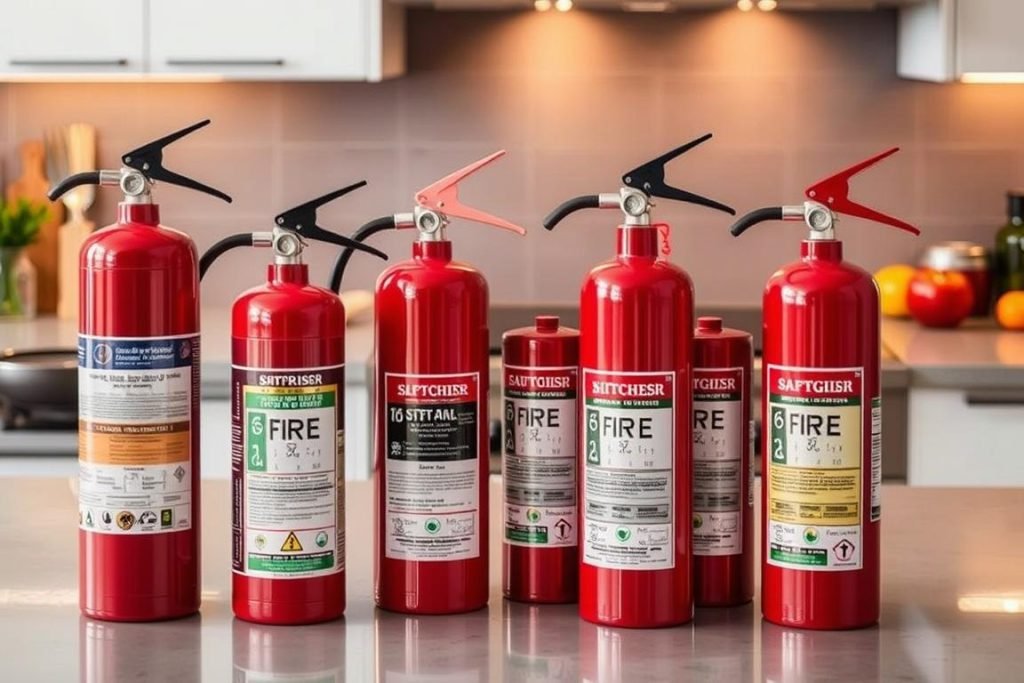
Choosing the Right Oil for Frying
The oil type matters as much as the food you fry. Picking the right oil enhances flavor, health, and safety. It’s vital for a great cooking experience.
Types of Cooking Oils
Oils vary for different frying needs. Avocado oil, with its high smoke point of 520°F, is ideal for high heat. However, butter has a low smoke point of 300-350°F. It’s good for light sautéing, not frying.
Oil Smoke Points Explained
Oil’s smoke point is when it starts to smoke and lose good qualities. It may even form bad compounds. For deep frying, choose oils like avocado, canola, or cottonseed. They can handle more than 400°F. This keeps cooking safe.
Flavors and Health Considerations
Flavor and health matter when picking oils. Canola oil, for example, has a mild flavor. It’s also healthy with fats that don’t hide food’s taste. Oils like corn and sunflower are rich in linoleic acid. This makes them great for health-focused cooking.
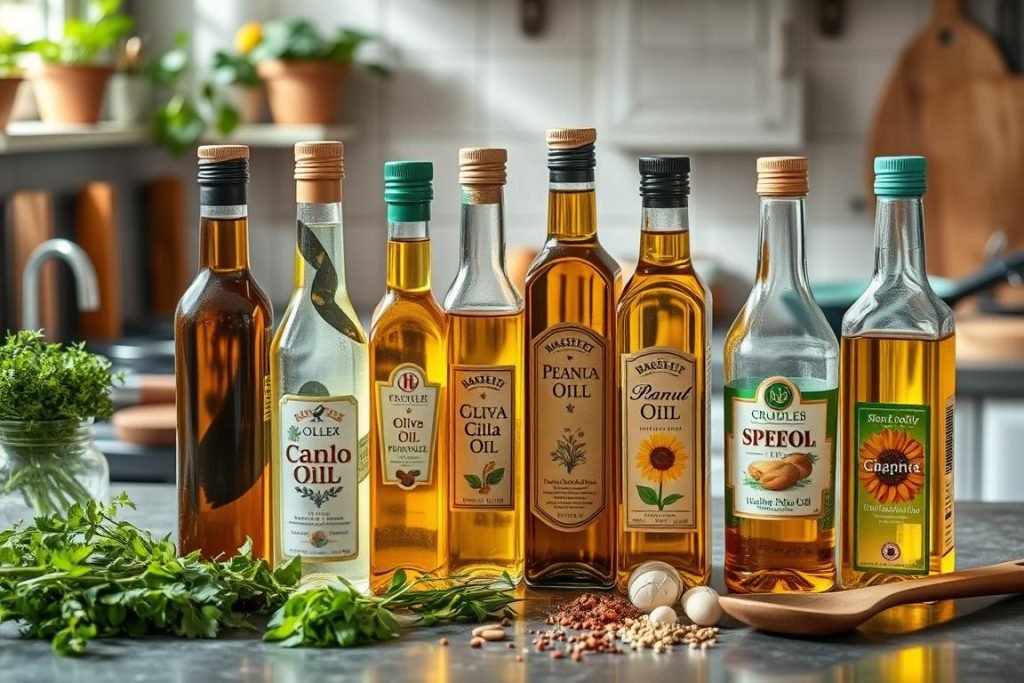
Select oils with the right smoke points for safe frying. This prevents grease fires. The right oil improves both safety and dish quality. Whether frying veggies or chicken, the correct oil boosts both.
Preparing Food for Frying
Before you fry, it’s key to get food ready for safety and quality. Handle ingredients well and heat the oil right to cut risks and make food feel good. This helps make your dishes safe and tasty.
Cutting Techniques for Frying
Cutting food the same size helps it cook even. This keeps the oil temperature stable, making it easier to manage. Same-sized pieces cook at the same rate. This avoids some parts getting too crispy while others stay soft.
It’s important to keep frying safe. Make sure all food hits the safe temperature inside. This keeps everything cooked right and safe to eat.
Marinating and Seasoning Tips
Marinating adds taste and safety. Always marinate in the fridge to stop bacteria growth. Make sure your food is dry before frying to keep oil from splashing. Season right before frying to help control the oil temperature.
Breading and Batter Basics
Right breading and battering protect your food and keep oil temperature just right. Make sure coatings are even and not too wet. Wetness under the coating turns into steam, making oil splash and not safe.
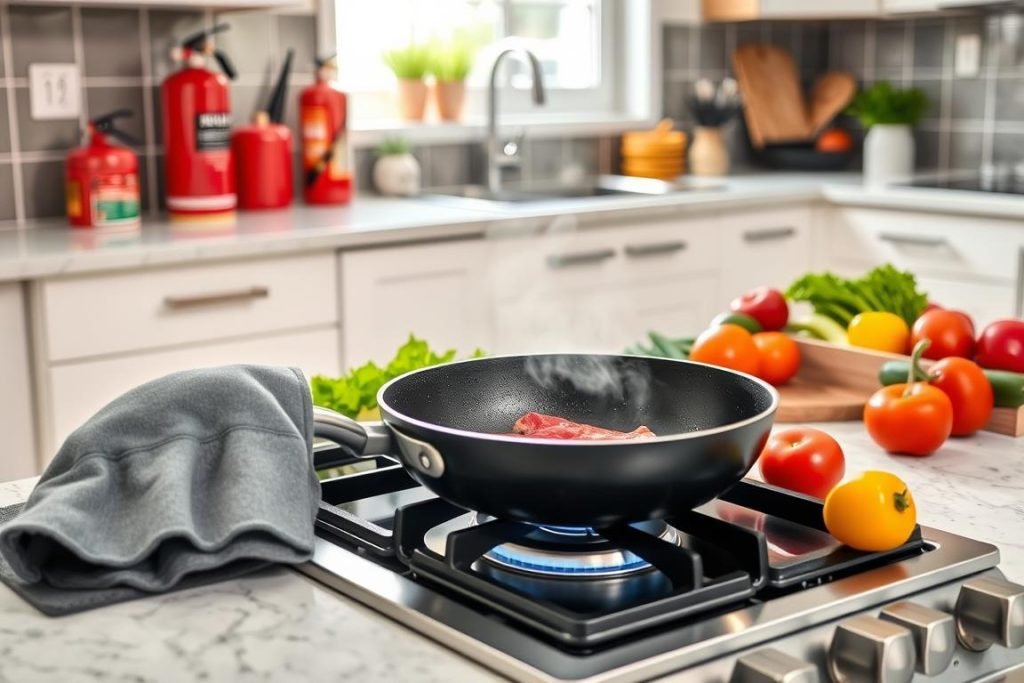
Talking about frying safety, let’s look at managing used oil and keeping the right temperature. Don’t reuse oil that looks cloudy or foamy. Always throw it away safely to keep your kitchen safe. Remember, holding the right oil temperature is key. Use a good thermometer to make sure your food ends up crispy and safe every time.
The Frying Process Step-by-Step
Frying food is about knowing how to work with hot oil safely. We’ll cover heating the oil, checking its temp, and how to add food. It’s key to use the right tools and keep safety in mind always.
Heating the Oil
The first step is to heat the oil right. Using stuff like a big stove or an electric fryer helps spread the heat well. Pick an oil, like peanut or canola, that doesn’t smoke easily. Heat it slowly to between 350°F and 375°F, ideal for frying.
Testing Oil Temperature
Getting the oil temp right is very important. It stops food from under or overcooking. Use a cooking thermometer to check the oil. This keeps food tasting good and stops the oil from catching fire.
Adding Food to the Oil
Add food to the oil without making a splash. Use tools like a spoon with holes or a fry basket. This keeps you safe and keeps the oil temp steady. Cold food can make the oil’s temp drop fast.
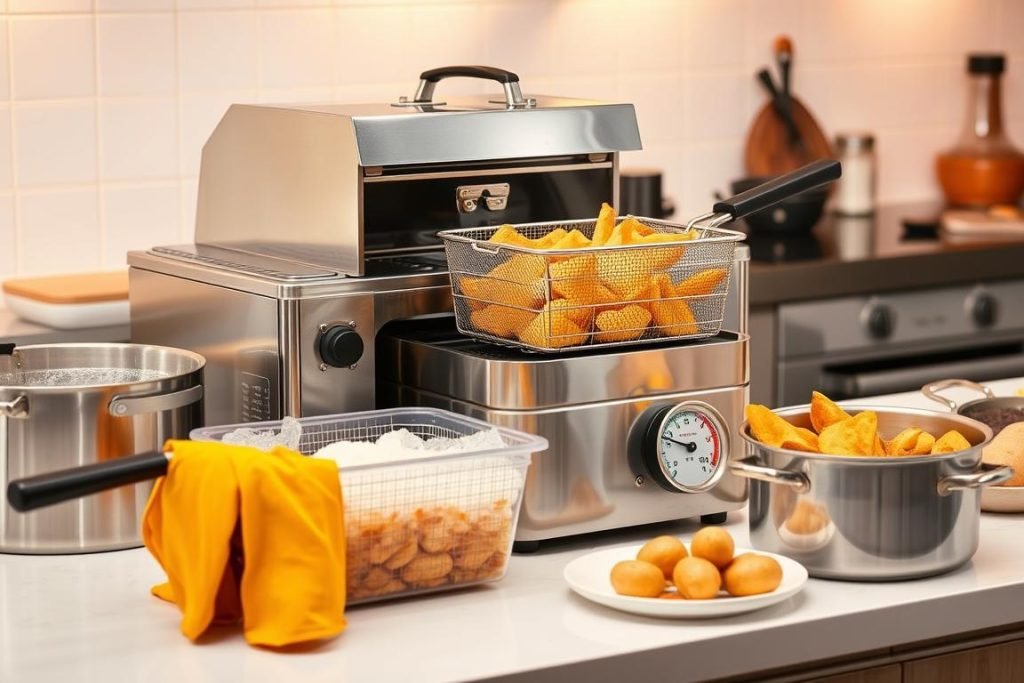
Follow these steps and use the right tools to fry like a pro. Pay attention to the oil and safety. This will make your cooking stand out.
Monitoring Food While Frying
When frying, it’s important to keep the oil at the right temperature. Following safety tips helps get good results and keeps the kitchen safe. Watching the food closely avoids problems like overcrowding and overheating. These issues could force you to use a kitchen fire extinguisher.
Timing and Techniques
Using the right timing and techniques is key to frying well. Almost all accidents can be avoided with the correct tools and methods. Keeping an eye on the oil temperature stops it from smoking or catching fire. It’s good to have a kitchen fire extinguisher ready. Also, putting food in at the right temperature makes it taste and feel better.
Avoiding Overcrowding the Pan
Most frying accidents happen because the pan is too full. Too much food at once makes the oil cool down. This makes the food cook badly and become too oily. Adding food in small amounts gives each piece space to cook right. This makes the food better and lowers the chance of oil spillover, which can start fires.
Using a Thermometer
Checking the oil temperature with a thermometer can stop most accidents. These often happen when the oil gets too hot. This tool keeps the oil temperature safe, making sure the food cooks well without risks.
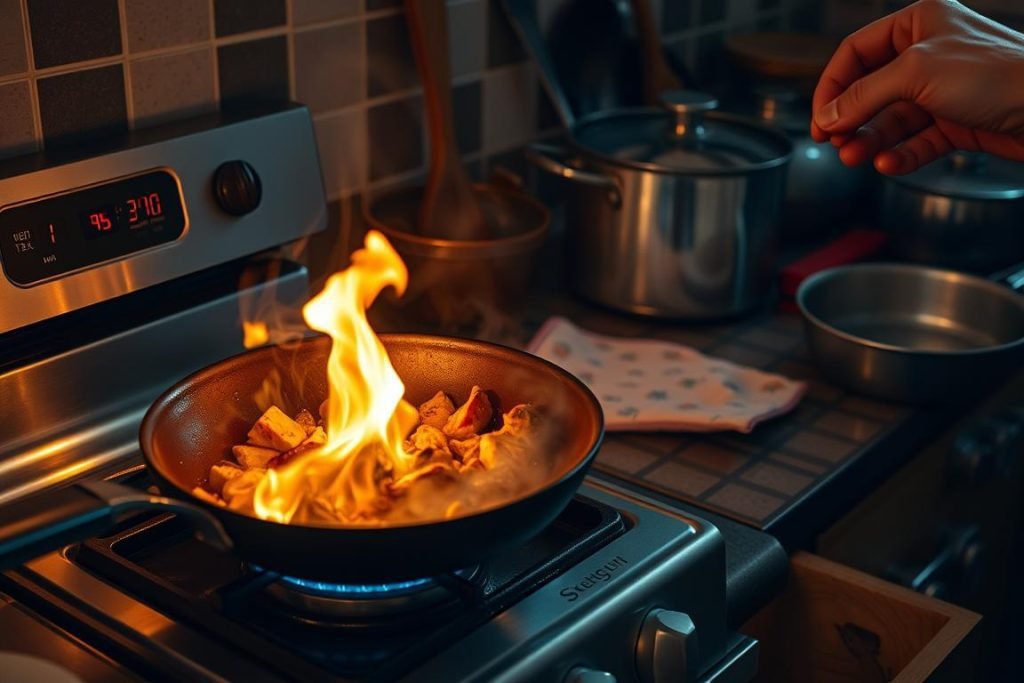
Due to health worries, places like KFC and Taco Bell now use healthier oils. These oils are free from trans fats, helping customers stay healthy while making food taste great. These changes show the need to cook in ways that are good for health but still make delicious food. By following these frying tips and using fire extinguishers carefully, anyone can fry food well and safely.
Frying Techniques Explained
Frying is a key skill in cooking. There are main methods like shallow frying, deep frying, and stir-frying. Each has its steps and needs care in managing Temperature Control. To get great results, keeping your fryer in good shape is needed. This helps it last longer and keeps your kitchen safe. Always have Kitchen Fire Extinguishers ready.
Shallow Frying
Shallow frying cooks food in a little oil. It’s enough to cover food halfway. This way is good for small foods. They get a crunchy outside and stay juicy inside. You don’t need to completely cover the food in oil.
Deep Frying
Deep frying cooks food fully in oil. It needs good Temperature Control to stop oil from getting too hot. This method is great for making crunchy fries or perfectly fried chicken. You have to keep the oil between 325°F and 400°F. Below, you’ll find a table with details on how to keep your oil and fryer at their best:
| Aspect | Detail |
|---|---|
| Fryer capacity | 15 – 200 pounds based on the model |
| Optimal oil temperature | 325 F – 400 F |
| Oil stability with antioxidants | Up to 350 hours |
| Recomended fry-pot fill limit | Two-thirds of capacity |
Stir-Frying
Stir-frying is fast and uses high heat. You keep moving the food. It’s great for veggies and soft meats. This method shows why Temperature Control and good fryer care matter. It stops food from sticking or cooking wrong.
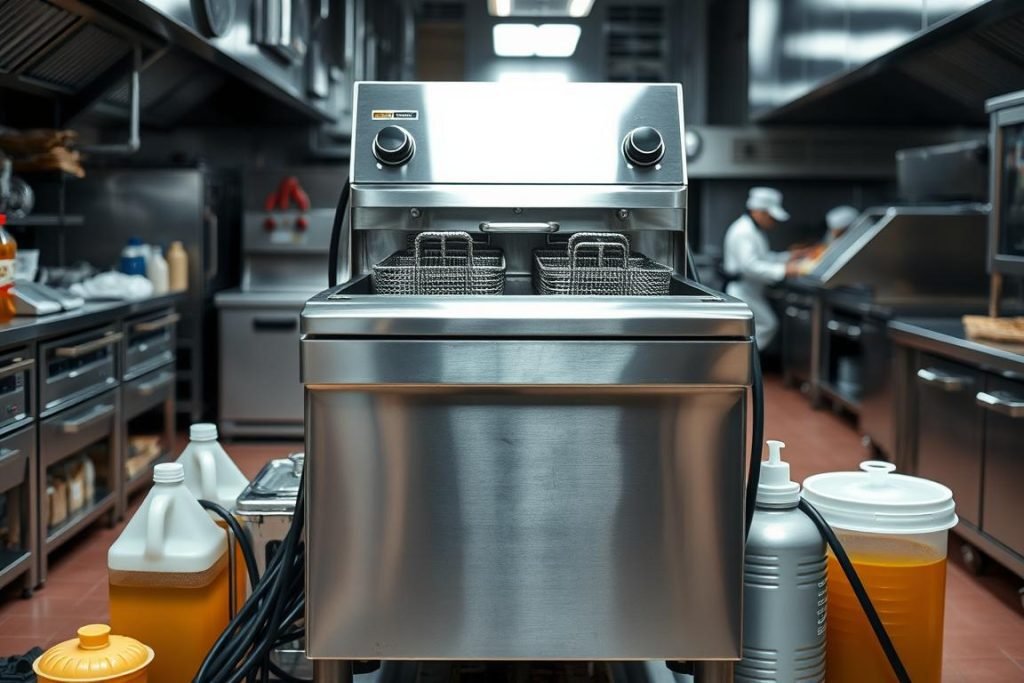
Tips for Perfectly Fried Food
Frying food well takes more than just good recipes and ingredients. It requires close attention to Frying Pan Safety, proper Deep Frying Equipment, and Hot Oil Handling skills. These aspects are key to tasty food and kitchen safety.
Achieving a Golden Brown Color
To get that perfect golden brown color, keeping the oil temperature steady is crucial. This means you’ll need a good deep-fry thermometer. A reliable thermometer cuts the risk of overheating oil by 75%. Managing the temperature right stops oil fires and keeps your food tasty and crisp.
Maintaining Crispiness
For crispy fried foods, timing and not overfilling the fryer matter a lot. Too much food at once can make things cook unevenly and turn soggy. Frying in smaller batches is better by 70% for keeping things crispy. Good Deep Frying Equipment ensures food cooks well, giving each piece enough room and oil.
Avoiding Greasy Residue
Avoiding too much grease involves proper draining and the right temperatures. Letting oil cool for about two hours before getting rid of it helps keep things safe. Sadly, half of cooking equipment fires come from misuse, like leaving food cooking alone or bad oil handling. Tools like splatter screens and the right gear lower such risks.
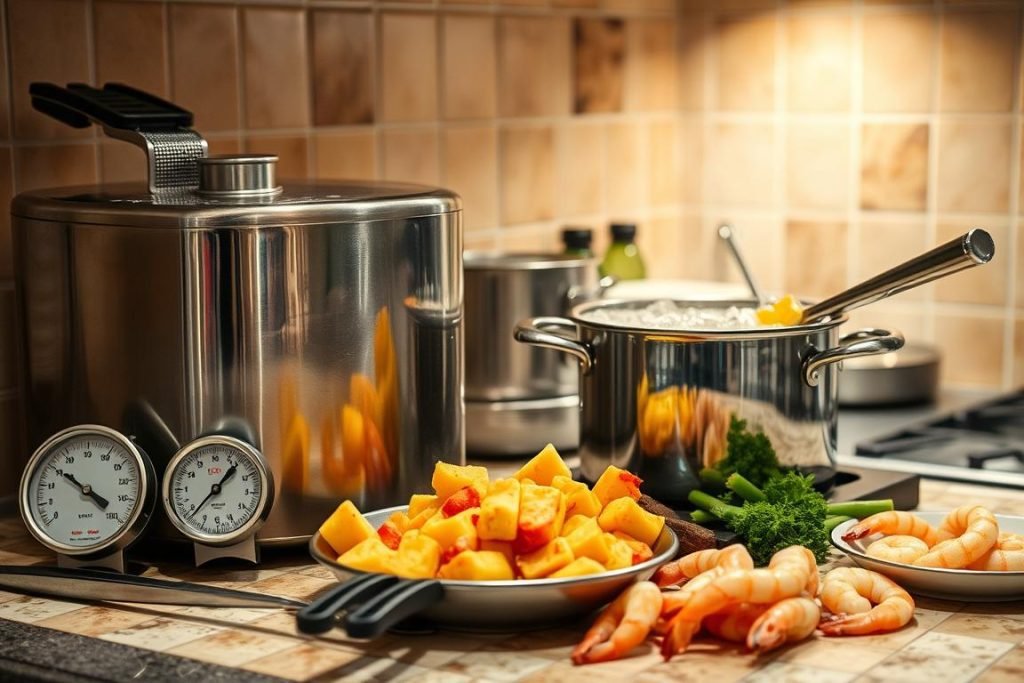
The key to perfect fried food is practice, knowing your equipment, and sticking to safety measures. Sadly, 90% of injuries from deep fryers come from not using right equipment or mishandling oil. Good Deep Frying Equipment, respecting high heat, and following safety tips can improve your frying results greatly.
Common Mistakes to Avoid
Frying right needs careful steps and knowing what to do. Many mistakes can make your meals unsafe or taste bad. We’ll look at these errors and how to fix them for better cooking.
Overheating the Oil
Keeping the Cooking Oil Temperature right is key for safe frying. Overheated oil can make bad substances and increase the chance of a Grease Fire Prevention. Aim for an oil temperature of 345-360 degrees Fahrenheit. This helps avoid risks and makes your food taste and feel better.
Underseasoning Food
Not adding enough seasoning can make food taste not as good. Adding spices before frying brings out great flavors. Taste and adjust the seasoning as you cook to make every fried dish better.
Skipping the Drainage
It’s important to get rid of extra oil to keep your food crispy, not greasy. Use a cooling rack or paper towels. This keeps the crunch in heavily battered food.
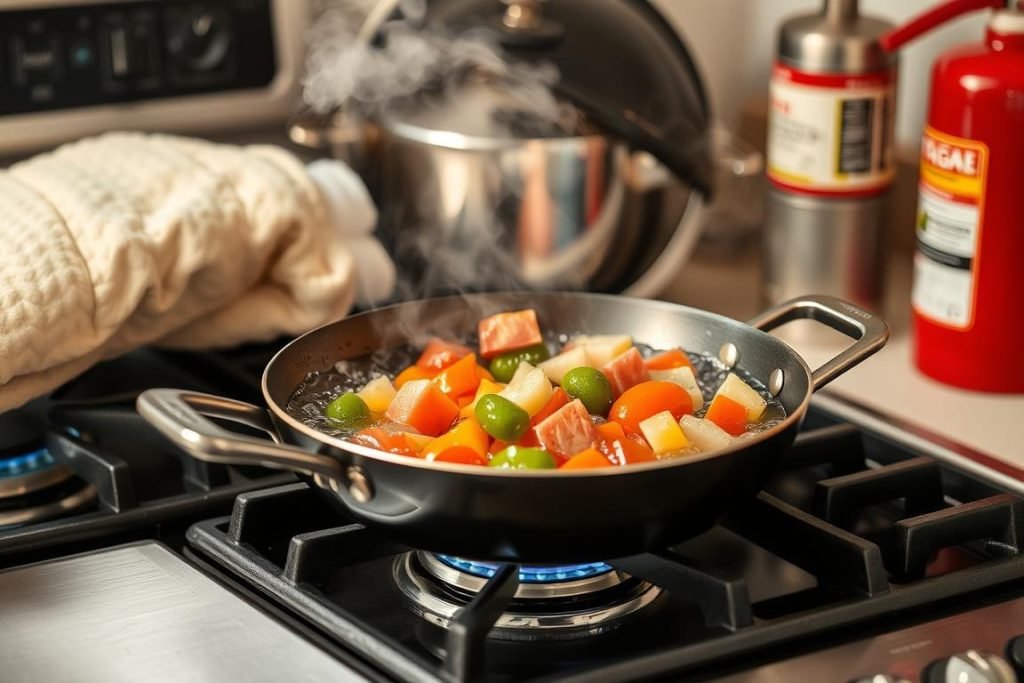
Using these tips can make frying safer and your food better in taste and quality. Think of frying as a mix of science and heart. Paying attention to temperatures and how you cook can upgrade your fried meals.
| Common Mistake | Consequences | Solutions |
|---|---|---|
| Overheating Oil | Risk of fires, health hazards, unpleasant tastes | Maintain oil temps between 345-360°F |
| Underseasoning | Bland food | Adjust seasoning pre-frying |
| Skipping Drainage | Excess oiliness, soggy texture | Use cooling racks or paper towels |
Avoiding these mistakes means your frying will be safer, cleaner, and your food will taste crispy and seasoned well.
Serving and Pairing Fried Dishes
Have you learned to fry with Frying Pan Safety and Temperature Control? Next, focus on serving and pairing your dishes. Thoughtful serving makes meals even better. Choose sides and sauces that boost your main dish’s flavor. Keep using Frying Safety Tips after cooking to keep meals safe.
Ideal Sides for Fried Foods
Picking right sides balances the rich taste of fried foods. Fresh salads or steamed veggies add a fresh touch. They make fried dishes shine more. For fried chicken, try these sides:
- Buttermilk biscuits
- Creamy coleslaw
- Mashed potatoes
Sauces that Complement Fried Dishes
The right sauce makes fried dishes even better. It could be smooth homemade honey mustard or deep barbeque sauce. The sauce should lift the fried item’s taste. It should not overpower it. Here are some favorites:
- Honey mustard sauce
- Garlic aioli
- Spicy ketchup
Pairings should match the flavors and textures well. They should honor the high cook temperature. Proper Temperature Control is key here.
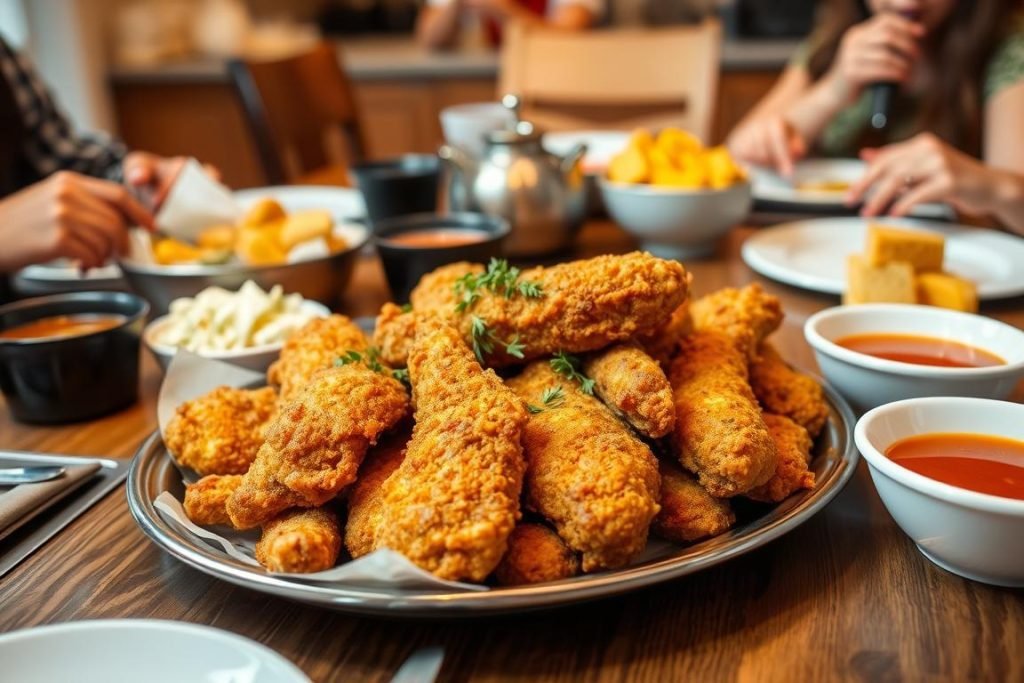
| Method | Cooking Temp (°F) | Time (minutes) | Internal Temp (°F) |
|---|---|---|---|
| Dutch oven | 350-375 | 12-14 | 165 |
| Cast-iron skillet | 350 | 20-24 (10-12 per side) | 165 |
| Deep fryer | 350 | 12-15 | 165 |
Always remember safety when frying. Use Frying Safety Tips after cooking for safe storage. Focusing on Frying Pan Safety and Temperature Control ensures high-quality meals. This makes every meal safe and enjoyable.
Cleaning Up After Frying
After you fry food, cleaning up is key to keep your gear good for next time. Good cleaning keeps your kitchen safe and your equipment in top shape. Doing this well means your frying tools can last longer and stay clean.
Proper Oil Disposal Methods
It’s important to throw away used oil the right way. First, let the oil cool down. Then, find out how to dispose of it without harming the environment. In many places, you can turn used oil into biodiesel, which is good for the Earth. Always store used oil in a sealed container away from heat until you can get rid of it safely.
Cleaning Your Frying Gear
Keeping your fryer clean is key for it to work safely and well. Clean it after each use. Remove food bits and wash everything with a strong cleaner or soap. Taking the fryer apart and scrubbing all parts, like the basket and lid, stops bad buildups. This makes sure your fryer works great and stays safe.
Reducing Odors in the Kitchen
Using frying pans safely means also keeping your kitchen smelling nice. Clean often and use things like vinegar or baking soda to get rid of bad smells. Boil water with vinegar to make the air smell better after cooking. Making sure your kitchen has good air flow when you cook and after helps a lot too.
| Maintenance Task | Frequency | Professional Tip |
|---|---|---|
| Light Cleaning | Daily | Remove loose food particles and wipe surfaces. |
| Deep Cleaning | Weekly | Disassemble parts and use specialized cleaning agents. |
| Oil Replacement | As needed | Monitor oil condition; change if cloudy, rancid, or foamy. |
| Odor Control | After each use | Simmer vinegar or use baking soda to absorb smells. |
Exploring Advanced Frying Techniques
If you love food and trying new things, advanced frying techniques can be exciting. It’s important to know how to fry safely and keep the oil at the right temperature. When frying, whether it’s with tempura batter or adding herbs, you need to manage the heat. This helps make the perfect fried food and keeps it safe from grease fires.
Tempura and Batter Variations
Tempura and different batters need you to be careful and precise. The oil should be between 350°F and 375°F for the best crispy texture. This temperature stops the food from soaking up too much oil. Don’t put too many things in the pan at once. Use a heavy pan to keep the oil temperature steady. It’s important to drain and blot each piece to keep it crispy and not greasy.
Using Different Flavor Infusions
Adding flavors to your frying oil can make your food taste even better. Keeping the oil at the right temperature is key to getting it just right. Always check the temperature, especially when frying big things like a turkey. It should reach at least 170 degrees inside. Set up your fryer safely to avoid fires and get delicious results.
Frying with Herbs and Spices
Frying with herbs and spices can make simple food taste amazing. It’s something everyone can try. Cook in small amounts and use fresh, good quality ingredients. This keeps the oil at the right temperature and the flavors strong. Remember, frying is about combining timing, temperature, and taste carefully. Always be safe by keeping the fryer away from anything that can catch fire and watch it closely.